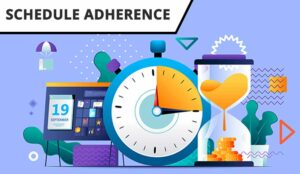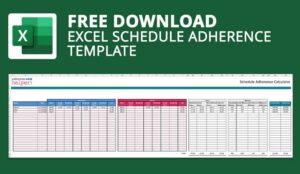There’s a lot riding on your contact centre schedule. Does it have enough coverage for each channel? Does it meet your agents’ needs? Does it have the right tasks at the right times? Will customers get service in the time they expect?
Even when you get it all set, making sure agents stick to your carefully crafted schedule can be a challenge. But how well your agents follow their schedules is an important metric to manage in your contact centre — one called schedule adherence.
What Is the Schedule Adherence Definition in a Contact Centre?
Schedule adherence is a contact centre KPI calculated as a percentage representing how much an agent followed the tasks originally scheduled for them — and at the scheduled time — across a day.
Schedule adherence is easily overlooked because it can be difficult to calculate without a Workforce Management System. A WFM tool supports and automates recording the tasks we want the agent to complete and when the agent completes them.
The Importance of Tracking Schedule Adherence
Schedule adherence is important for successful forecasting. In an ideal scenario, you would create the perfect schedule from an inbound forecast and hit your expected KPIs for any given day.
But that only happens if the schedule is followed as directed — which is what makes schedule adherence such a vital KPI to measure and manage. In fact, it’s one of the top 10 metrics contact centres measure.
What’s the Formula to Calculate Schedule Adherence in a Contact Centre?
To calculate schedule adherence, you need to record when tasks are set and when tasks are actually completed by agents.
Formula for Schedule Adherence(%):
(Total Scheduled Time – Total Time Out of Adherence)) ÷ Total Scheduled Time = Schedule Adherence (%)
If a task is started early, late, extended in length, or cut short and completed early, this deviation needs to be recorded. The amount of time in the correct state vs. the total time of the shift is the schedule adherence for the day.
For example, correctly switching tasks and completing the correct tasks for the day will net 100% schedule adherence in an eight-hour shift. However, failure to switch tasks to complete a 15-minute task during that shift would net 96.875% adherence.
Contact Centre Schedule Adherence Benchmarks
Nobody’s perfect, so expecting 100% schedule adherence for every agent every day is unrealistic. The most efficient contact centres will aim for 95% schedule adherence each day.
- Good Adherence – 75%
- Strong Adherence – 85%
- Best Adherence – 95%
If an agent isn’t sticking to their schedule at least 75% of the time, dig deeper into why. It could be that agents aren’t properly trained to report time out of adherence, potentially skewing the real numbers. Or they might just need more coaching on how to stay on schedule for the day.
Always keep in mind that working with customers isn’t an exact science — sometimes chats take longer than expected or calls need extra attention. Allow for some deviation from the expected schedule and give your agents some breathing room.
After learning the schedule adherence definition and the formula for calculating it, you’re probably looking for ways to improve this key metric. Three easy tactics can help you improve your schedule adherence.
1. Use Real-Time Monitoring
There’s no greater tool for monitoring and improving schedule adherence than real-time reporting. A WFM calculates schedule adherence in real time for team leaders, managers, or administrators to view and monitor. With up-to-the-minute data, you can help agents who are falling behind get back on track.
Real-time schedule adherence monitoring through software is a big improvement over manual methods. Manually calculating schedule adherence the following day and only providing periodic updates to lower-performing agents isn’t effective and it hurts your contact centre’s productivity overall.
These agents’ lack of adherence can cause gaps in coverage that require you to change other agents’ schedules to cover. Addressing adherence issues as they happen in real time is far more effective and doesn’t create scheduling headaches — for you or your team.
2. Set Realistic Intraday Tasks
It’s one thing to monitor agents, but it’s another to avoid setting them up to fail. I previously wrote about 3 tips for optimizing your contact centre schedule.
Creating an optimized schedule goes hand in hand with improving your schedule adherence by accounting for breaks, meetings, and ad hoc tasks that occur once a day or once a week.
By taking the time to create accurate, complete schedules, you can make it easier for your team to stay on track and boost your schedule adherence numbers.
Developing a realistic overview of the tasks occurring daily will also improve your understanding of your available capacity and help you avoid under- or over-staffing.
3. Get Training Right
Unlike a metric such as Average Handling Time (AHT), which you can obtain without agent input, schedule adherence relies on agents to provide the right information for you to compare against the original schedule. It’s crucial to train agents to provide accurate information properly.
A tool like Playvox WFM makes this easier by integrating with your contact centre CRM (such as Zendesk). Within the CRM, it gives your agents an easy-to-use widget to update their current task.
Using these three tips, you can improve your agents’ schedule adherence, improve your own understanding of an agent’s typical day, and use the adherence data for accurate forecasting going forward.
Using current, accurate shrinkage information, you can better calculate your day-to-day capacity and account for agent requirements given the forecasted inbound volume.
With improved schedule adherence, you’ll know your agents will be following what you schedule better and your expectations for daily performance will be more likely to be met.
Schedule adherence is a powerful tool for any contact centre that’s looking for simple ways to improve efficiency and realize the associated savings.
Author: Guest Author
Published On: 21st Jul 2022
Read more about - Guest Blogs, Playvox



































